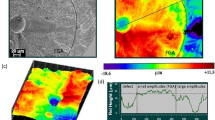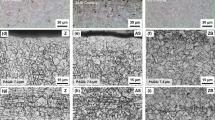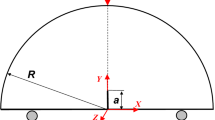Abstract
EXPERIMENTAL, results obtained from mild steel plates containing small edge cracks subjected to reversed direct stress loading (that is, zero mean load) have suggested that whether or not a crack grows is governed by the parameter σ3 l (σ = nominal alternating stress, tons/sq. in., l = length of edge crack, inches)1. If the value of σ3 l is greater than 5.5, a crack will grow ; if less, it will remain dormant. It has been shown1–4 that with certain notched specimens, non-propagating cracks may be present at the root of the notch of those tested at stresses equal to and below the conventional notched fatigue limit (that is, for specimens either remaining unbroken or being completely broken). When the geometry of the specimens is such that non-propagating cracks are present, the conventional notched fatigue limit is independent of the radius of the notch root and is equal to the alternating stress required to propagate the crack. This depends on the depth of the notch, for it has been shown1 that the relationship σ3 l = 5.5 is applicable if l is taken as the depth of notch plus the length of non-propagating crack formed.
This is a preview of subscription content, access via your institution
Access options
Subscribe to this journal
Receive 51 print issues and online access
$199.00 per year
only $3.90 per issue
Buy this article
- Purchase on Springer Link
- Instant access to full article PDF
Prices may be subject to local taxes which are calculated during checkout
Similar content being viewed by others
References
Frost, N. E., Proc. Inst. Mech. Eng., 173, No. 35 (1959).
Frost, N. E., Aeronaut. Quart., 8, 1 (1957).
Frost, N. E., and Dugdale, D. S., J. Mech. Phys. Solids, 5, 182 (1957).
Isibasi, T., and Uryu, T., Reports of Research Inst. for Applied Mech., Kyushu University, 4, 107 (1956).
Frost, N. E., and Dugdale, D. S., J. Mech. Phys. Solids, 6, 92 (1958).
Author information
Authors and Affiliations
Rights and permissions
About this article
Cite this article
FROST, N. Correlation of the Alternating Stresses required to initiate and propagate a Fatigue Crack in Mild Steel. Nature 187, 233–234 (1960). https://doi.org/10.1038/187233a0
Issue Date:
DOI: https://doi.org/10.1038/187233a0
This article is cited by
-
Observation of small fatigue crack growth behavior in the extremely low growth rate region of low carbon steel in a hydrogen gas environment
International Journal of Fracture (2013)
Comments
By submitting a comment you agree to abide by our Terms and Community Guidelines. If you find something abusive or that does not comply with our terms or guidelines please flag it as inappropriate.



